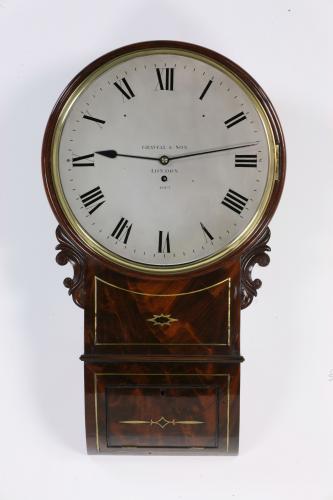

Price
£28000.00This object is eligible for a Certificate of BADA Provenance
The BADA Standard
- Since 1918, BADA has been the leading association for the antiques and fine art trade
- Members are elected for their knowledge, integrity and quality of stock
- Our clients are protected by BADA’s code of conduct
- Our dealers’ membership is reviewed and renewed annually
- Bada.org is a non-profit site: clients deal directly with members and they pay no hidden fees
Vulliamy No. 317. An Ormolu and Bronze Mounted White and Black Marble Mantel Timepiece. Date 1801.
An extremely attractive and rare mantel timepiece. The marble case, with inset engine turned and gilded panels to the front and sides, stands on nicely shaped gilt feet. It has a gilded beaded border to the top of the main plinth. The clock set within a white marble drum shaped casing with marble scrolls supporting it and with a finely engraved and gilded small panel in the black marble base. At the sides of the case are two beautifully cast and chased bronze lions, each guarding a gilt ball. The case is surmounted by a flat urn finial with engine turned highlights.
The eight day fusee movement has a 3½″ enamel dial with well chased and gilded hands. It has a half deadbeat escapement and rise and fall regulation to the pendulum which is numbered 317. It is signed and numbered on the backplate Vulliamy, London, No. 317. There is a turn buckle to the brass rear door.
The clock comes with a later purpose made numbered and signed key and a copy of the Vulliamy Workbook for its manufacture. It was delivered to Mr Palmer on the 6th February 1801.
The Vulliamy Workbook records the various makers of the different parts of the clock and it is interesting that the marble supplied by Day actually cost more than the movement which was supplied by Bullock, who was one of Vulliamy’s best clockmakers. Also interesting is that the chasing of the cast lions was 4 guineas whereas the castings themselves were only 18 shillings.
Benjamin Vulliamy was probably the most widely talented and artistic member of the clockmaking family. He was born in 1747 and died in 1811. His skills not only related to his clock and watch making but also to the case work and artistic side of the business. He was granted the Royal Appointment as the King’s Clockmaker in 1773 and although his father had sold many clocks to George III it was Benjamin who developed the connection and gave personal advice on horological matters in which the King was keenly interested.
He is known principally for his fine ornamental clocks, many with biscuit porcelain figures and ormolu decoration in the French taste. However, he also made a number of fine regulators, one in particular made in 1775 for the Royal Family is now in the Science Museum, although another regulator is still at Buckingham Palace.
In 1781 he was admitted to the Clockmakers’ Company as an Honorary Freeman.
Provenance:
1801 Palmer Esq.
2010 Sotheby’s, London.
Dimensions
Height: 10½″ (27 cm.) Width: 11½″ (29.5 cm.)Stock number
851The BADA Standard
- Since 1918, BADA has been the leading association for the antiques and fine art trade
- Members are elected for their knowledge, integrity and quality of stock
- Our clients are protected by BADA’s code of conduct
- Our dealers’ membership is reviewed and renewed annually
- Bada.org is a non-profit site: clients deal directly with members and they pay no hidden fees



